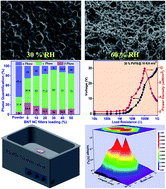Method for fabricating highly crystalline polyvinylidene fluoride for piezoelectric energy-harvesting and vibration sensor applications†
Abstract
The present work focused on forming highly crystalline polyvinylidene fluoride (PVDF) films and applying them to energy-harvesting and sensor applications. Bar-coated PVDF thin films with the loading of Bi0.5Na0.5TiO3 (BNT) filler were fabricated under controlled humidity conditions for improved film crystallinity. The piezoelectricity of the PVDF films depended on the preparation conditions and resulting crystallinity. The electroactive (EA) phases, β and γ of PVDF, exhibited good piezoelectric properties, contrary to the non-electroactive (NEA) α phase. Achieving a high EA with lower NEA is necessary to achieve highly efficient energy conversion and self-powered sensor applications. Probe sonication induced a high-EA PVDF solution, tape cast under high-humidity conditions with the BNT filler, resulting in a 92% EA phase. The optimized configuration included 30 wt% BNT filler used in a PVDF-based piezoelectric nanogenerator (PVFB PENG). Under a force of 10 N, the 30% PVFB PENG produced 29.5 V/500 nA, with an instant power density of 11.8 mW m−2. The PVFB PENG was tested under the effects of poling, acceleration, switching polarity, and capacitor charging, and exhibited good stability up to 6000 s. Sonication-induced vibration was converted into an electrical response and utilized to monitor and identify the highly active regions in an ultrasonic bath. The PVFB PENG upon the biomechanical motion of foot-tapping resulted in generating 27 V/400 nA.



 Please wait while we load your content...
Please wait while we load your content...